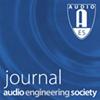非均匀边界条件和耦合房间晚混响的高效计算模拟
IF 1.6
4区 工程技术
Q3 ACOUSTICS
引用次数: 6
摘要
为了提高计算效率,可以通过产生由空间分布的虚拟混响源(VRS)辐射的具有频率相关指数衰减的有限数量的非相干信号来简化晚期混响的声学模拟。需要足够数量的VRS和足够的空间映射来近似空间各向异性的晚混响,例如,在吸收分布不均匀的房间或耦合体积中。此外,对于耦合室,可能需要双斜率衰减。在这里,提出了一种有效的和感知上合理的方法来产生和空间渲染晚混响。(子)体的非相干VRS信号是基于空间尺寸和边界处的频率相关吸收系数产生的。对于耦合房间,(声学)通道考虑了房间连接处的声音传播和衍射以及混响衰减过程中的能量传递的影响。VRS在空间上分布在听者周围,加权因子表示边界上吸收的空间次采样分布以及入口所覆盖的位置和立体角。技术评估和听力测试证明了该方法与真实房间测量结果的有效性。本文章由计算机程序翻译,如有差异,请以英文原文为准。
Computationally-Efficient Simulation of Late Reverberation for Inhomogeneous Boundary Conditions and Coupled Rooms
For computational efficiency, acoustic simulation of late reverberation can be simplified by generating a limited number of incoherent signals with frequency-dependent exponential decay radiated by spatially distributed virtual reverberation sources (VRS). A sufficient number of VRS and adequate spatial mapping are required to approximate spatially anisotropic late reverberation, e.g., in rooms with inhomogeneous distribution of absorption or for coupled volumes. For coupled rooms, moreover, a dual-slope decay might be required. Here, an efficient and perceptually plausible method to generate and spatially render late reverberation is suggested. Incoherent VRS signals for (sub-) volumes are generated based on room dimensions and frequency-dependent absorption coefficients at the boundaries. For coupled rooms, (acoustic) portals account for effects of sound propagation and diffraction at the room connection and energy transfer during the reverberant decay process. The VRS are spatially distributed around the listener, with weighting factors representing the spatially subsampled distribution of absorption on the boundaries and the location and solid angle covered by portals. A technical evaluation and listening tests demonstrate the validity of the approach in comparison to measurements in real rooms.
求助全文
通过发布文献求助,成功后即可免费获取论文全文。
去求助
来源期刊

Journal of the Audio Engineering Society
工程技术-工程:综合
CiteScore
3.50
自引率
14.30%
发文量
53
审稿时长
1 months
期刊介绍:
The Journal of the Audio Engineering Society — the official publication of the AES — is the only peer-reviewed journal devoted exclusively to audio technology. Published 10 times each year, it is available to all AES members and subscribers.
The Journal contains state-of-the-art technical papers and engineering reports; feature articles covering timely topics; pre and post reports of AES conventions and other society activities; news from AES sections around the world; Standards and Education Committee work; membership news, patents, new products, and newsworthy developments in the field of audio.
 求助内容:
求助内容: 应助结果提醒方式:
应助结果提醒方式:


